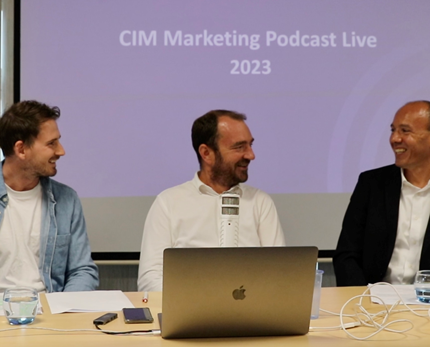Questions and answers from Podcast LIVE 2023

- 11 August 2023
Back in July, CIM hosted the second Podcast LIVE event to round off CIM Marketing Podcast’s fourth season.
As attendees took their places in CIM Moor Hall’s Redgrave Suite, they gathered to hear AI and MarTech insights from Microsoft’s Ryan Miles and CIM’s and Getinference’s Vincent Sider, moderated by Ben Walker, CIM’s podcast host.
With 45 minutes given over to engaging discussion between our panel, the end of the hour was opened up to the audience and their questions picked up from the prior discussion. These are their questions, and the panel’s informative answers.
To see the event for yourself, watch the Podcast on YouTube, listen on Spotify, Apple or the platform of your choice, or do both on the CIM Content hub.
Questions and answers from Podcast LIVE 2023
Useful AI terms:
- Hallucinations – when AI fabricates information, yet is confident it’s true. Also called ‘false information generation’
- Context tokens – how an AI breaks down a prompt to generate responses in a conversation
- Prompt – ‘asking’ an AI to do something, whether conversation or task. Slightly different from a human ‘request’ requiring iterative refining and reordering words whereas humans can normally work with nuance
- Dataset – most ‘AI’ is actually a tool that’s been trained library of data that it then appears to reference when prompted (though usually it’s not accessing the library directly). This library is the dataset, and relates to ‘training data’
- Generative AI – the step after machine learning, where the AI has been given data and when prompted can provide ‘new’ text, images, video. Machine learning recognising existing patterns – “these are pictures of dogs”
- Discriminative AI – These tools can identify the distinctions in your data and group it into specific categories or classes
How do we guarantee AI gives us the truth?
Ryan Miles’ focus was understandably on what is being done at Microsoft to combat this problem, particularly around the new Bing, which is being trained to reference. “Where it makes comments, it references its source, so instead of having to really dig for information you click it, see the source, and decide for yourself if it's reputable.”
Not all sources are created equal. CIM’s marketing information should be seen as more reputable than a day-old WordPress site, and AI tools should be able to reflect this in the same way search engines currently do. While they evolve that at Microsoft, more companies will start doing the same.
However, Ryan correctly pointed out that “plugging into a proprietary data set within your own organisation is currently the best way to ensure truth from AI.”
What are the Top AI tools?
Vincent Sider fielded this question, as you might expect from a CIM course director, and his response around his subject was referred to as “encyclopaedic”.
AI for Copy
A new AI for copy comes out every day, not least because it's now so easy to create them – the tools can almost literally create themselves. But there are still dominant tools. Vincent Sider highlighted Chat GPT for its simplicity and free access if used for research, and Bard. “I use them to cross-check back to the issue of hallucination, what does this one say when this one says that.”
Vincent then drew particular attention to Claude from Anthropic due to the large queries available - 100,000 context tokens at the time of writing. This means you can feed it a huge amount of information in one request, “which means you can have real conversations because it can connect the dots”
To highlight what that means in context, ChatGPT is limited to 4,000 tokens, which to Vincent “isn’t enough to get the full picture when you have complex subjects to address”.
AI for imagery
For images, the AI conversations often start with Midjourney, which has recently been in trouble in the US for accusations of copyright violations. Vincent offered an equivalent in Adobe Firefly, stating “Adobe Firefly guarantees protection against any IP issues because they've used their own training data”, rather than lifting from other image datasets like Midjourney reportedly did with DeviantArt.
If you have any fears about copyright infringement in your AI imagery, Adobe Firefly is a safe bet for now.
AI for video
If you’re in the video space and wish to explore AI, you can start with animation-type video and Kaiber was called out by Vincent as “a good tool to create animation on the fly”. From a source picture, you can describe what you’d like the picture's subject(s) to do or where to end up, and you will get an interpolated animation from that starting point to the endpoint.
It’s then for you or your animator to go in and clean it, as AI often struggles with hands and clear consistency between frames.
In the world of text-to-video, Runway ML is a generative AI that can take text as an input and convert it into a video of around 12 seconds. Vincent was quick to point out that this 12-second limit means it’s “not yet ready for primetime”.
AI for data
Vincent touched upon how to use AI tools for data interrogation, returning back to the most well-known tool, ChatGPT, and plugins. ChatGPT has a code interpreter plugin which can use Python, and handle uploads and downloads, meaning you can give the AI data and ask ChatGPT to explain it, along with ask it to output or check code.
After the Generative AI world of ChatGPT, there is also discriminative AI, which according to Vincent is “how to use your data to predict behaviours to cluster their audiences”. He highlighted Microsoft’s Azure AI, in a nod toward Ryan, and a tool called Data IQ, “which is visual local, and I can build prediction model in five minutes with that tool”.
With all of those together, Vincent felt those present now had “perfect arsenal here to do whatever you want. Just don’t ask Chat GPT for the best tools – because it's going to hallucinate.”
Do you think we have a responsibility to educate our businesses, as well as individually upskilling, about how to respond to the use of AI?
While Ryan felt that it's the duty of everyone who sees the value in these tools to use them responsibly, and advocate for the same, Vincent felt that it more came down to those in the C-suite to choose the right models, understand them and know the principles behind their creation.
Ryan referred to the adoption curve in his explanation, and that it was the early adopters (a large contingent of which are marketers) that carried the most responsibility to “demonstrate how AI can be responsibly used”. This would then accelerate adoption amongst those lagging behind.
Both panellists agreed that simply not knowing how something works wasn’t sufficient to avoid responsibility around data privacy and responsibility. Ryan was of the opinion that “You have to interrogate what tool you're going to use and answer why it is the right one, or the safe one”, while Vincent elaborated that “you don’t need to understand how the algorithms work, that’s for the IT department. But then they have to rely on their marketing colleagues to make the right responsible choices.”
From the juniors to the C-suite, if you’re versed in AI tools then it becomes your responsibility to see your colleagues educated on them. If you aren’t yet but would like to be, CIM’s newly launched AI courses featuring Vincent Sider and other AI experts will increase your knowledge considerably.
How, as professionals, can we have a sensible conversation about AI positivity, rather than constant fear?
Over the course of Podcast LIVE, repeated reference was made to Terminator 2 and other media where AI is portrayed at the height of negativity – world-ending, humanity-threatening and above all, uncontrollable.
Again, both panellists were in agreement, that this media portrayal is incorrect for a number of reasons. Not only is AI a misnomer in its current form - it’s not truly intelligent but “patterns and connections” according to Vincent – but also it can only do what it’s told, and thus unlikely to run roughshod over humanity.
Ryan was careful to point out that “there is a fear around what it does to jobs and some sectors that might be different to others”, and earlier in the session it was highlighted that mainly junior workers were the most concerned. So long as we “keep demonstrating where it augments our capabilities”, it will make jobs easier rather than remove them. From copywriter to copy prompt engineer.
Vincent returned to Gartner’s hype cycle, mentioned earlier in the evening. A two-year window between the start of a technology’s adoption and its eventual plateau where those in the know or industry can make a competitive advantage. Once we reach the plateau, the end of those two years, “we'll forget about this fear, because it's going to be so embedded in whatever we do”.
He also reported that users of generative AI see its “kindness”, and at CIM we too have seen how ChatGPT appears nothing but helpful. It’s not perfect yet by any means, as no marketing tool truly is, but ask it a question and it’s either quick to be helpful, or apologetic when it isn’t.
The end of the answer was focused on education, as understanding how AI works, the “patterns and connections”, is the greatest remover of fear.
How are niche sectors going to be able to utilise AI technology to improve their SEO for visibility and quality?
Ryan was quick to identify that the more niche your sector, the greater the challenge of having an AI that can support you well with up-to-date information. He reiterated that AI is not intelligent, “it's got to build from something”. And if it doesn’t have that specialist dataset, then it can't draw from it.
In a study of 40 million queries made on Google in the US in 2019, 50% of them weren’t clicked on. While SEO has been on the marketing agenda for a long time, it clearly still has space to grow, and AI-powered chatbots might be the solution. Train an AI chatbot on your niche sector knowledge, use the datasets that made you a specialist, and you can “scale your knowledge and expertise very, very quickly”.
Vincent also had some points on the power of chatbots for SEO. While the content of chatbots doesn’t factor into search results, if they give good answers, keep users on your site for longer and help them find the information they seek, your site will be seen positively when search queries relate to it due to that user engagement. Chatbots when done right can “make the experience on your website so amazing that they talk about it to others. That’s the new SEO.”
Vincent also leaned into a more technical answer, first focussing on the web layout/data encoding format JSON LD. ChatGPT can produce information in this format, and using it on your or your client’s website is becoming a larger part of being seen positively by the algorithms. Currently “only 40% of the world’s websites” use it, so simply by using JSON LD with ChatGPT’s help you can raise your niche content higher in the eyes of Google and Bing.
Learn more about AI from Vincent Sider and other CIM course directors on our new AI-specific courses.

- 0 views

 FAQs
FAQs
 Log in
Log in
 MyCIM
MyCIM






